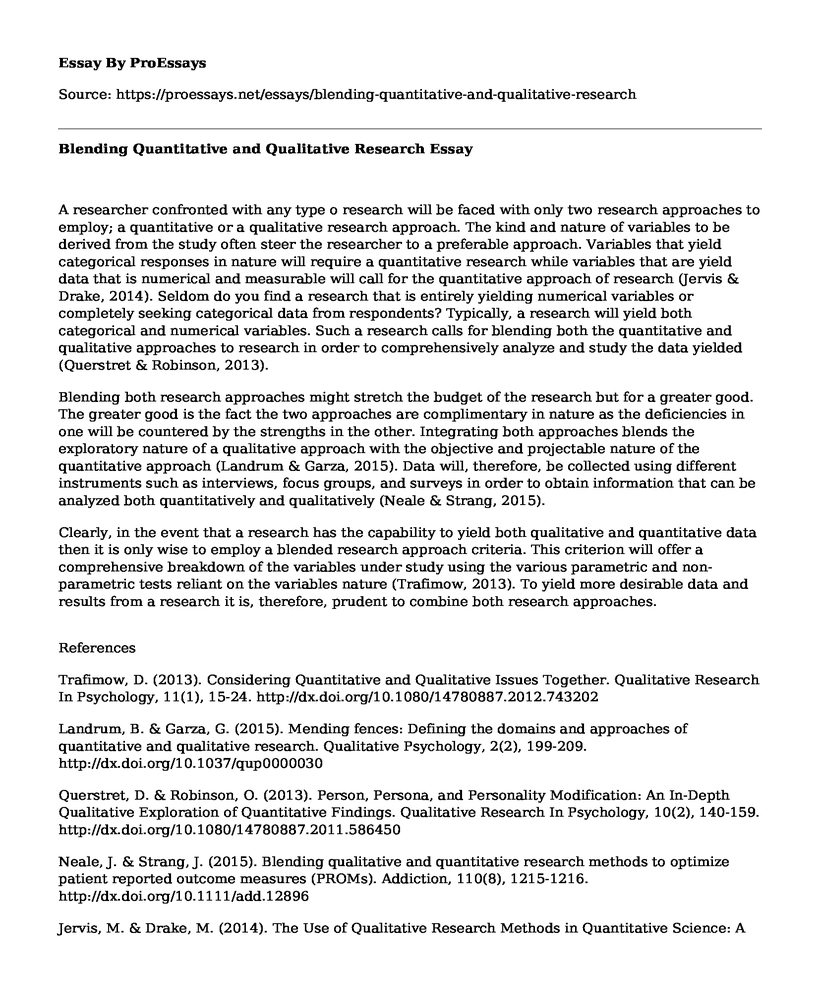A researcher confronted with any type o research will be faced with only two research approaches to employ; a quantitative or a qualitative research approach. The kind and nature of variables to be derived from the study often steer the researcher to a preferable approach. Variables that yield categorical responses in nature will require a quantitative research while variables that are yield data that is numerical and measurable will call for the quantitative approach of research (Jervis & Drake, 2014). Seldom do you find a research that is entirely yielding numerical variables or completely seeking categorical data from respondents? Typically, a research will yield both categorical and numerical variables. Such a research calls for blending both the quantitative and qualitative approaches to research in order to comprehensively analyze and study the data yielded (Querstret & Robinson, 2013).
Blending both research approaches might stretch the budget of the research but for a greater good. The greater good is the fact the two approaches are complimentary in nature as the deficiencies in one will be countered by the strengths in the other. Integrating both approaches blends the exploratory nature of a qualitative approach with the objective and projectable nature of the quantitative approach (Landrum & Garza, 2015). Data will, therefore, be collected using different instruments such as interviews, focus groups, and surveys in order to obtain information that can be analyzed both quantitatively and qualitatively (Neale & Strang, 2015).
Clearly, in the event that a research has the capability to yield both qualitative and quantitative data then it is only wise to employ a blended research approach criteria. This criterion will offer a comprehensive breakdown of the variables under study using the various parametric and non-parametric tests reliant on the variables nature (Trafimow, 2013). To yield more desirable data and results from a research it is, therefore, prudent to combine both research approaches.
References
Trafimow, D. (2013). Considering Quantitative and Qualitative Issues Together. Qualitative Research In Psychology, 11(1), 15-24. http://dx.doi.org/10.1080/14780887.2012.743202
Landrum, B. & Garza, G. (2015). Mending fences: Defining the domains and approaches of quantitative and qualitative research. Qualitative Psychology, 2(2), 199-209. http://dx.doi.org/10.1037/qup0000030
Querstret, D. & Robinson, O. (2013). Person, Persona, and Personality Modification: An In-Depth Qualitative Exploration of Quantitative Findings. Qualitative Research In Psychology, 10(2), 140-159. http://dx.doi.org/10.1080/14780887.2011.586450
Neale, J. & Strang, J. (2015). Blending qualitative and quantitative research methods to optimize patient reported outcome measures (PROMs). Addiction, 110(8), 1215-1216. http://dx.doi.org/10.1111/add.12896
Jervis, M. & Drake, M. (2014). The Use of Qualitative Research Methods in Quantitative Science: A Review. J Sens Stud, 29(4), 234-247. http://dx.doi.org/10.1111/joss.12101
Cite this page
Blending Quantitative and Qualitative Research. (2021, Mar 14). Retrieved from https://proessays.net/essays/blending-quantitative-and-qualitative-research
If you are the original author of this essay and no longer wish to have it published on the ProEssays website, please click below to request its removal:
- A Rhetorical Analysis on Sarah Smarsh Research Findings
- SWOT and PESTEL Analysis of Nestle Corporation
- Analyzing Quantitative Research Methods
- Identification and Evaluation of Sources During Research Study Paper Example
- Essay Sample on Types of Interviews: Formal, Informal, Structured & Unstructured
- Poor Whites in America: Struggling to Survive - Research Paper Sample
- Essay Sample on Statistical and Clinical Significance







